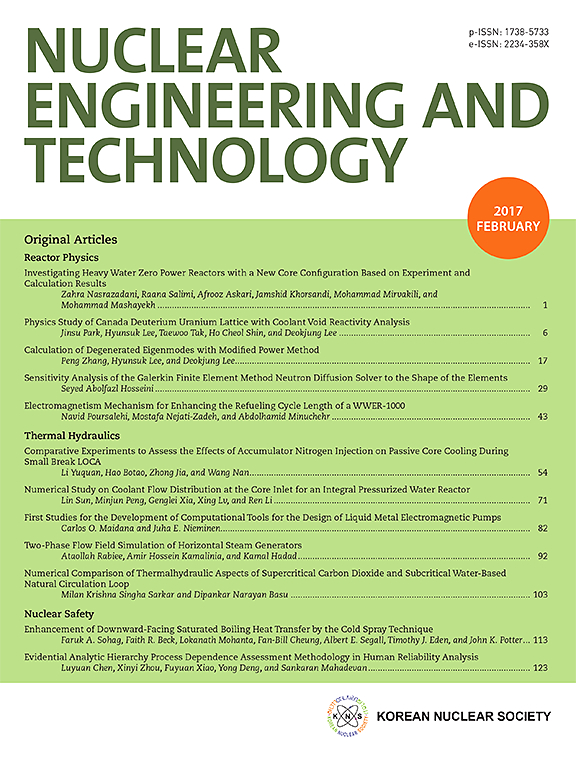bridgman生长CsPbBr3单晶高能、高剂量率x射线探测的探索
IF 2.6
3区 工程技术
Q1 NUCLEAR SCIENCE & TECHNOLOGY
引用次数: 0
摘要
钙钛矿基半导体由于其平衡的载流子输运、高有效原子序数和可调谐的电子特性而成为下一代辐射探测器的有希望的候选者。在这项研究中,我们研究了布里奇曼生长CsPbBr3 (CPB)单晶用于x射线探测的可行性,特别是在高能和高剂量率条件下。制备了Au/CPB/Au和Ga/CPB/Au两种平面器件,并对其进行了评价。由于肖特基势垒的形成,不对称的Ga/CPB/Au结构中含有低功功能金属,表现出明显的暗电流抑制和稳定性增强。电学表征表明,两种器件之间的陷阱密度相当,这证实了性能差异是由电极诱导的界面效应造成的,而不是由沉积过程中的热损伤等制造引起的影响。从低剂量率到诊断暴露,Ga/CPB/Au器件在广泛的x射线条件下表现出优异的性能,具有高信噪比(SNR),高灵敏度和低检测限(LoD)。值得注意的是,该装置即使在恶劣的x射线照射(6 MeV和>;1 Gy)下也能保持稳定的光电流和高灵敏度,验证了其稳健性和高能x射线剂量计的适用性。该研究表明,结合低功函数电极的CPB装置是在广泛的能量和剂量范围内可靠和敏感的x射线检测的可行候选者。本文章由计算机程序翻译,如有差异,请以英文原文为准。
Exploration on high-energy and high-dose rate X-ray detection with Bridgman-grown CsPbBr3 single crystal
Perovskite-based semiconductors have emerged as promising candidates for next-generation radiation detectors due to their balanced carrier transport, high effective atomic number, and tunable electronic properties. In this study, we investigate the feasibility of Bridgman-grown CsPbBr3 (CPB) single crystals for X-ray detection, particularly under high-energy and high-dose-rate conditions. Two types of planar devices, Au/CPB/Au and Ga/CPB/Au, were fabricated and evaluated. The asymmetric Ga/CPB/Au configuration, incorporating a low work function metal, exhibited significantly suppressed dark current and enhanced stability, attributed to Schottky barrier formation. Electrical characterization revealed comparable trap densities between both devices, confirming that performance differences resulted from electrode-induced interface effects rather than fabrication-causing effect such as thermal damage during deposition. The Ga/CPB/Au device demonstrated superior performance across a wide range of X-ray conditions from low dose-rate to diagnostic exposures, with high signal-to-noise ratio (SNR), high sensitivity, and low limit-of-detection (LoD). Notably, the device maintained stable photocurrent and high sensitivity even under harsh X-ray exposures (6 MeV and >1 Gy), validating its robustness and applicability for high energy X-ray dosimeter. This study demonstrates that CPB devices incorporating low work function electrodes are viable candidates for reliable and sensitive X-ray detection across a broad energy and dose range.
求助全文
通过发布文献求助,成功后即可免费获取论文全文。
去求助
来源期刊

Nuclear Engineering and Technology
工程技术-核科学技术
CiteScore
4.80
自引率
7.40%
发文量
431
审稿时长
3.5 months
期刊介绍:
Nuclear Engineering and Technology (NET), an international journal of the Korean Nuclear Society (KNS), publishes peer-reviewed papers on original research, ideas and developments in all areas of the field of nuclear science and technology. NET bimonthly publishes original articles, reviews, and technical notes. The journal is listed in the Science Citation Index Expanded (SCIE) of Thomson Reuters.
NET covers all fields for peaceful utilization of nuclear energy and radiation as follows:
1) Reactor Physics
2) Thermal Hydraulics
3) Nuclear Safety
4) Nuclear I&C
5) Nuclear Physics, Fusion, and Laser Technology
6) Nuclear Fuel Cycle and Radioactive Waste Management
7) Nuclear Fuel and Reactor Materials
8) Radiation Application
9) Radiation Protection
10) Nuclear Structural Analysis and Plant Management & Maintenance
11) Nuclear Policy, Economics, and Human Resource Development
 求助内容:
求助内容: 应助结果提醒方式:
应助结果提醒方式:


